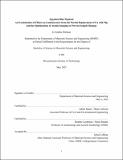Egyptian Blue Pigment: An Examination of Effects on Luminescence from the Partial Replacement of Cu with Mg, and the Optimization of Atomic Imaging to Prevent Sample Damage
Author(s)
Mittman, Sophia
DownloadThesis PDF (254.0Mb)
Additional downloads
Advisor
Masic, Admir
Lechtman, Heather
Terms of use
Metadata
Show full item recordAbstract
This research examines the correlation between Egyptian blue pigment luminescence and magnesium inclusions, in addition to atomic imaging of ancient Egyptian blue. Egyptian blue (CaCuSi4O10 crystals and a flux matrix) was the first synthetic pigment created, discovered by ancient Egyptians around 3000 BC. This material has merit both as a stable synthetic pigment that has lasted thousands of years, but also as a modern material under study for uses in energy-saving applications due to its near-infrared luminescence.
To engineer Egyptian blue and maximize its luminescent properties, understanding how various inclusion atoms affect the microstructure of Egyptian blue is critical. Current studies observe that magnesium inclusions increases luminescence. Thus, the first module of this thesis correlates Egyptian blue luminescence with the partial replacement of copper with magnesium. Analyses including scanning electron microscopy (SEM), electron dispersive spectroscopy (EDS), and Raman spectroscopy were performed. It was found that magnesium trends towards sodium-rich phases, forms clumps of entirely different phases, and does not itself luminesce. Given these results, further studies are needed to identify why luminescence is, in fact, enhanced by magnesium inclusions, since intensity of luminescence was not measured in this study.
In the second module of this research, both modern and ancient samples of Egyptian blue were exfoliated and examined under scanning transmission electron microscopy (STEM). The underlying goal was to quantify compositional changes across crystalline-amorphous interfaces to accurately estimate original Egyptian blue formulae. However, each sample was damaged when STEM was performed. Thus, beam energies and microscope settings were altered in attempts to prevent this damaging. Before damaging occurred, though, high-resolution images of atoms in the cuprorivaite lattice were imaged, which is the first Egyptian blue atomic imaging of its kind.
Date issued
2022-05Department
Massachusetts Institute of Technology. Department of Materials Science and EngineeringPublisher
Massachusetts Institute of Technology